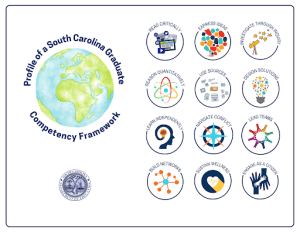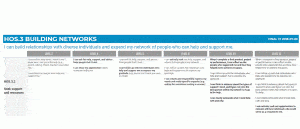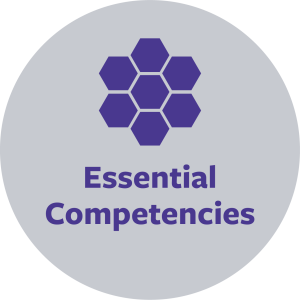Design Considerations for Student Competency Frameworks
CompetencyWorks Blog
Competency frameworks form the foundation for a competency-based education system by clarifying learning outcomes. How can learners move on when ready if we haven’t clearly defined what it means to “be ready”? How can they learn anytime, anyplace without being able to articulate, demonstrate, and reflect on what they have learned?
This post looks at several design considerations that can shape the structure and functioning of student competency frameworks, building on other efforts to provide clarity and guidance for understanding how competencies differ from (and are similar to) grade level academic standards. This post is inspired by a series of conversations earlier this year with Sandra Moumoutjis of Building 21 and Jeri Thompson (one of the authors of this post about the Implementation and Outcomes of Personalized, Competency-Based Learning). Please approach these design considerations as a work in progress and reach out about what resonates, what is useful, and how you might refine them.
Digging Into Design Considerations
From our perspective, competency frameworks should be transparent, transferable, continuous, and holistic. But how do you know that each of these things are true? Let’s unpack it.
Transparent
To what extent does the learner know the learning goals and interact with them regularly in their learning?
Educators should first consider the level of transparency of the competencies in their framework. This is a primary threshold for a competency-based system and one that we suggest can be used to differentiate a standards-referenced or standards-based system from a competency-based system. Students should have easy access to and knowledge of the competencies against which they are being assessed. If educators are using and tracking student progress on the competencies, but students aren’t aware, the foundations for competency-based learning are there, but not fully enacted. Transparency of the competencies is a key part of ensuring equity is embedded in a school’s pedagogy (CBE element 6) and addressing the first five CBE elements requires the visibility of the competencies.
Transferable
To what extent are the competencies transferable across contexts?
The structure of your competency framework will determine how transferable the competencies are across settings. First, how you assess a student’s progress and growth on a competency will influence whether the competencies are primarily situated within each discrete discipline or can be applied more broadly across disciplines and contexts. For example, if you create science competencies based on the Next Generation Science Standards (NGSS) disciplinary core ideas (e.g., molecules, the solar system), they will likely apply only within science courses. If you use the NGSS practices (e.g.,collecting and analyzing data, modeling), they will apply to science, but it is possible to make connections to how these skills can also be used in history or mathematics.
Pushing towards the highest level of transferability we currently see in the field, some competencies focus on skills and dispositions that apply across contexts and disciplines. The Profile of the South Carolina Graduate (PSCG) competencies, Chelsea Opportunity Academy (COA) competencies, and XQ competencies all maximize transferability. However, this doesn’t mean that highly transferable competencies don’t attend to content knowledge. A well designed performance task allows you to determine how well the student applied the content knowledge to the competencies demonstrated. Even if the competency framework doesn’t discreetly include content knowledge, it can still be mapped into the curriculum and be the vehicle through which transferable competencies are developed and measured.

Continuous
To what extent are the competencies supportive of the learner’s growth over time?
Another structural element is the degree of continuity between performance levels articulated in the framework. The highest degree of continuity can be found in a progression-based design. In a progression-style structure, the developmental complexity of the competency is visible in the performance levels of the competency, which are laid out as a continua/progression. The progression (along with supporting resources, such as examples of what performance looks like at each level) allows the learner to concretely see how to deepen their understanding and ability to apply the competency at higher levels of sophistication.
Depending on the number of performance levels, progression-style design also tends to focus more on age or grade bands, rather than year by year increments. This shifts the focus to more fluid development over time, rather than annual benchmarks. Additionally, while progressions could be written for a specific discipline, they are typically used across disciplines. Building 21’s competency framework and reDesign’s Future 9 (as well as South Carolina and XQ) are examples.

Competencies designed at the course- or grade-level have a lower degree of continuity. This approach more closely mirrors the structure of most state standards, which have specific grade-levels and content areas. While we can see how each grade level builds upon the last, the structure of most standards doesn’t emphasize this. The fourth grade teacher would have to make a specific effort to see how the third and fifth grade standards compare to the fourth grade ones.
Holistic
To what extent do the competencies expand the definition of student success?
CBE emphasizes a shift to higher-level competencies that include transferable skills and dispositions, in addition to academic knowledge and skills. The extent to which academic content and skills are integrated with the essential skills and dispositions (also called durable skills, habits, social-emotional skills, etc.) will shape the learning culture, pedagogy, and structures of a CBE system. When a competency framework values essential skills and dispositions that represent a broader definition of student success equally as academic skills, it is more holistic. This influences both tracking and reporting of outcomes, and what educators intentionally teach and assess. Portraits of a Graduate (also called a Profile of a Learner, Learner Outcomes, Graduate Profile, etc.) offer a promising entry point for defining a broader vision of learner success.
Some systems have one set of competencies that include both academic and dispositional skills. Nevada’s new Portrait of a Learner and the examples above illustrate holistic competency frameworks.
Other systems have a set of competencies, sometimes called habits of success or habits of mind, focused on social-emotional skills and dispositions that work in tandem with academic competencies or state standards. The Chicago Public Schools CBE pilot cohort takes this approach with a set of adaptive competencies. Vermont’s Proficiency-Based Graduation Requirements include academic content areas (e.g., math, English, science) as well as transferable skills that cross content areas (e.g., effective communication, creative and practical problem-solving).
Multiple Pathways to CBE (and to Competency Frameworks)
If we acknowledge that there is no single “right” way to design a competency framework and no single “pure form” of CBE, we can shift from the idea of “implementation with fidelity” to “implementation with integrity” – integrity to local communities and contexts and to what we know about how humans learn. Ideally, the CBE field can then support schools in finding their transformation pathway. I hope that this post makes a contribution to this effort by illustrating the multiple approaches to competency frameworks.
Learn More
- CBE Starter Pack 7: Establish Rigorous, Common Expectations with Meaningful Competencies
- Five Big Ideas for Learner-Centered Competency Framework Design
- Competency Frameworks and Content Selection at South Bronx Community Charter
 Laurie Gagnon is the CompetencyWorks Program Director at the Aurora Institute. She leads the work of sharing promising practices shaping the future of K-12 personalized, competency-based education (CBE). Laurie lives in Somerville, MA with her partner, young son, and cat.
Laurie Gagnon is the CompetencyWorks Program Director at the Aurora Institute. She leads the work of sharing promising practices shaping the future of K-12 personalized, competency-based education (CBE). Laurie lives in Somerville, MA with her partner, young son, and cat.